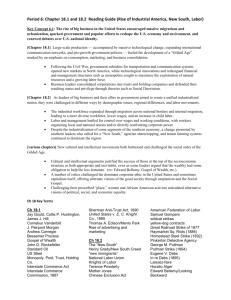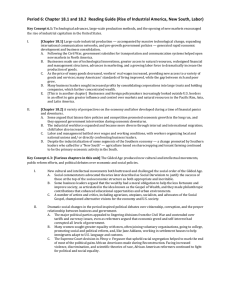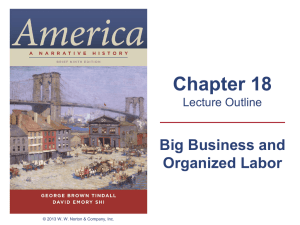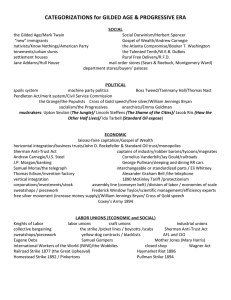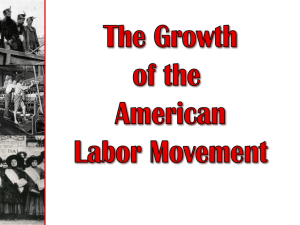Unit Two Notes
advertisement
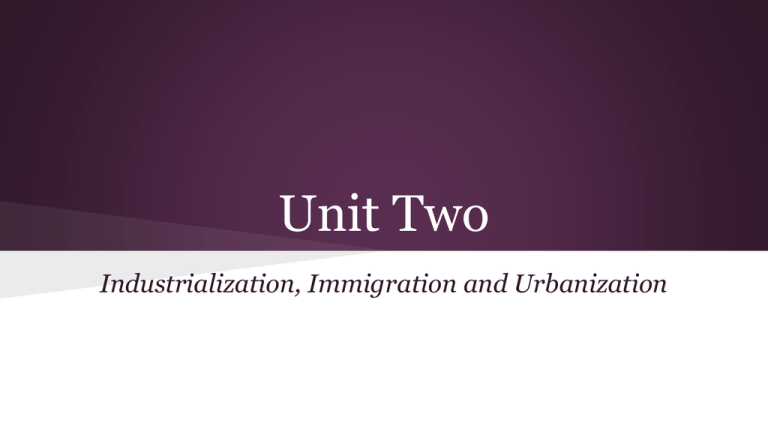
Unit Two Industrialization, Immigration and Urbanization Natural Resources The U.S. following the Civil War, and still today, had a wealth of natural resources. How did this abundance of raw materials help promote industrialization? Growing Urban Population More and more people began to move into cities following the Civil War. How did this migration of people help cause rapid industrialization? Government Support In the late 1800s, the government was favorable toward business interests. How did this support help industry grow rapidly? President William McKinley Inventions Numerous life changing inventions were developed following the Civil War. How did these new technologies help promote industrial growth? Entrepreneurs Following the Civil War, many entrepreneurs, or businessmen, emerged and made great profits from industry. How did men like Carnegie and Rockefeller help industry develop in the U.S.? Railroads Railroads expanded greatly after the Civil War. What role did railroads play in industrial growth? The economic development of the United States between 1870 and 1950 helped produce the results shown in the graph above. The trend shown in the graph is A. increased urbanization. B. decreased immigration. C. advances in communication. D. reduced population growth. Essential Question: What common characteristics can be found in the early “titans of industry”? Top 10 Largest American Companies (2006) Company Industry 1 Wal-Mart Retailing 2 Exxon-Mobil Oil and Gas Operations 3 General Motors Automobile 4 Chevron Oil and Gas Operations 5 Ford Motor Co. AUtomobile 6 ConocoPhillips Oil and Gas OPerations 7 General Electric Conglomerates 8 Citigroup Banking 9 AIG Insurance 10 IBM Software and Services Questions: 1. What are the three largest American companies? 2. Which industry is the represented the most on the top 10 list? 3. Why is Wal-Mart the largest American company when it sells everything cheaper? 4. Which companies do you think are on the rise? On the fall? Essential Question: How did the “titans of industry” build their business empires? Andrew Carnegie Steel Industry created a monopoly horizontal integration vertical integration What is a monopoly? when a business is able to control all aspects in a particular industry and eliminate competition to maximize profit How do they do it? horizontal integration-business buys out the competition ex: AT&T buys out T-Mobile verical integration-business buys out the suppliers ex: oil companies Horizontal and Vertical Integration Impacts of Monopolies Pro: Cons: ● allowed for major growth of industry ● huge profits were made ● competition was destroyed (prices were higher and choices were limited) ● created a large gap between the owners and the workers Why were monopolies allowed? ● hands off business policies of the government (laissez-faire) ● close ties between business leaders and government leaders Economic Impacts of Big Business ● U.S. becomes the leading industrial power in the world. ● Despite poor conditions, more people are earning more money than before. ● Industrialization grows as more people have more money to buy goods. What conditions led to the creation of labor unions? What were working conditions in the late 1800s? 12 or more hours per day six days a week (sometimes 7) no vacation, sick leave, unemployment compensation, reimbursement for injuries while on the job injuries common factories—dirty, poorly ventilated, poorly lit, faulty equipment repetitive tasks How did the titans of industry justify these conditions? social darwinism •based on work of Charles Darwin •some individual’s flourish and pass on their traits to the next generation; others do not •natural selection •justifies a hands-off approach •appealed to the Protestant work ethic “riches were a sign of God’s favor and therefore the poor must be lazy or inferior people who deserved their lot in life” So--what did workers do? They formed unions. 2 kinds of labor unions: craft unionism industrial unionism What were they hoping to accomplish? Knights of Labor “An injury to one is the concern of all.” membership open to all workers worked for an 8-hour workday and “equal pay for equal work” American Federation of Labor (AFL) all skilled workers collective bargaining used strikes collective bargaining negotiation between representatives of labor and management to reach written agreements on wages, hours and working conditions Strikes of the late 1800s The Great Strike of 1877 The Haymarket Affair The Homestead Strike The Pullman Strike Workers Unite to Strike The Haymarket Affair The Pullman Strike The Homestead Strike socialism economic and political system based on government control of business and property and an equal distribution of wealth Eugene Debs Industrial Workers of the World (IWW)
